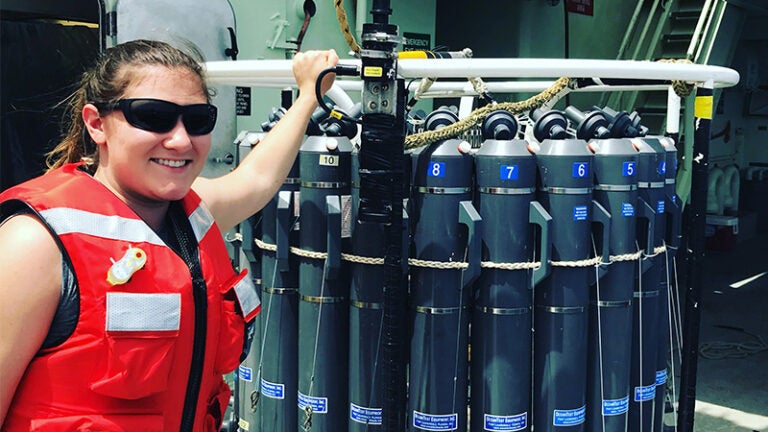
Researchers use metagenomics to discover thousands of new marine microorganisms
While many students spend their spring break on a cruise ship, Elaina Graham chose a different kind of get-away. There was no swimming pool. No steel drum band. No all-you-can-eat buffet. Instead, her month-long voyage across the Atlantic was riddled with bacteria.
Sailing from South Africa to Puerto Rico, she joined a group of scientists aboard the RV Atlantis — one of the most sophisticated research vessels in commission. When the USC Dornsife graduate student returned to Los Angeles, she brought back important souvenirs: bacterial DNA sequence data from ocean water samples.
Today, she collaborates with John Heidelberg, associate professor of biological sciences and environmental studies at USC Dornsife, and postdoctoral scholar Ben Tully to grow organisms that have never been found in nature — organisms that have been discovered through metagenomics.
Using a technique that directly samples microbial DNA from ocean waters, the scientists are reconstructing genomic sequences of environmental bacteria. These recomposed genomes allow them to ask questions about what microorganisms are doing in the ocean and the critical role they play in maintaining healthy biochemical cycles in marine ecosystems.
Innovating around the problem
“In the oceans where we work, better than 99 percent of the individual bacteria won’t grow in a lab,” said Heidelberg. “So we can’t do the first step that most people think of as the starting point for microbiology, which is growing the cells.”
This is where metagenomics comes in. Scientists take DNA sequence information extracted from entire microbial communities in their natural environment and compile the data in bulk. “The interest in our lab has been looking at whether we can you use these really big DNA datasets to reconstruct the organisms that are providing their genomic information,” Tully said.
Using data from the Tara Oceans expedition, the largest marine microbial dataset in existence, the USC team has a huge albeit unwieldy set of microbial genetic information to work with. Imagine trying to remake a single Wikipedia article by putting all of the words from every Wikipedia article into a hat, shaking it up, and picking out words at random.
When developing a metagenome, the “words” are genes and the “sentences” they form are genetic sequences. Scientists try to string thousands of these disparate sentences together to recreate a very specific “Wikipedia article” — or the genome of a living bacterium.
Sometimes the organisms revealed through the process have not yet been identified in nature by the scientific community, including thousands of species discovered by the USC Dornsife team. Estimates put the number of known marine organism genomes at about 3,500 prior to their research. Now there are more than 6,000.
“This is why the field of metagenomics has grown. It gives us insights as to what biology could be going on,” Heidelberg said. “And it’s not able to be done any other way.”
Primed for discovery
Creating a metagenome would be impractical were it not for software that can analyze and arrange the data. Dissatisfied with existing programs, Tully and Graham collaborated on developing an open-source computational tool called “BinSanity.” Scientists feed a dataset into the system, which identifies patterns consistent with known genomic sequences and organizes these into separate “bins.” A slight difference from known sequences could indicate a new organism.
The USC Dornsife team is especially interested in one particular finding of theirs. In the ocean, there are many organisms that perform photosynthesis. And there are other organisms called phototrophs that also have the capacity to use light, but only in a more direct way for energy. Until recently, these were two distinct groups.
As they were running data through BinSanity, Tully and Graham noticed genomes indicating another group of bacteria — one that can both use light as energy and take compounds from the ocean to fix carbon. While common among terrestrial plants and phytoplankton, this dual activity was previously undetected in the oceans.
“We’ve been able to present to the scientific community this new group of organisms that seem to be connecting these two spheres of previously unconnected biology,” said Tully.
Graham’s research cruise afforded a unique opportunity to further cement this connection. Using new samples she collected from the same areas covered in the Tara Oceans expedition, the team is exploring metagenomic sequences to find more evidence of these microbes, which they believe take in certain sulfur compounds. With this in mind, Graham is using sulfur-based chemical amendments to try to promote their growth in a laboratory setting.
“When we are doing our incubations and we add these certain sulfur compounds, it causes a change in biomass,” she said. Using molecular tools, they can determine if this increase in biomass is due to the microbes multiplying.
“It’s a good sign that something is growing,” Graham said, “because most of the conditions I’m using are very specific and not a lot of other bacteria are known to grow like that.”
If the scientists can nurture the microbes to grow in the lab, the research could reveal a new world of marine microbiology.
About the study
Funding provided by the National Science Foundation through its Science and Technology Center Program’s Center for Dark Energy Biosphere Investigations.